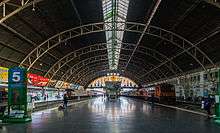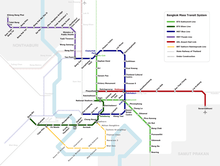Bangkok railway station
Bangkok railway station สถานีรถไฟกรุงเทพ | |||||||||||||||||||||||||||||||
|---|---|---|---|---|---|---|---|---|---|---|---|---|---|---|---|---|---|---|---|---|---|---|---|---|---|---|---|---|---|---|---|
 | |||||||||||||||||||||||||||||||
| Location | Rama IV Rd, Pathum Wan, Bangkok, 10330 | ||||||||||||||||||||||||||||||
| Coordinates | 13°44′20″N 100°31′0″E / 13.73889°N 100.51667°ECoordinates: 13°44′20″N 100°31′0″E / 13.73889°N 100.51667°E | ||||||||||||||||||||||||||||||
| Owned by | State Railway of Thailand | ||||||||||||||||||||||||||||||
| Line(s) |
Northern Line Northeastern Line Eastern Line Southern Line | ||||||||||||||||||||||||||||||
| Platforms | 14 | ||||||||||||||||||||||||||||||
| Connections | MRT, BMTA | ||||||||||||||||||||||||||||||
| Construction | |||||||||||||||||||||||||||||||
| Disabled access | Yes | ||||||||||||||||||||||||||||||
| Other information | |||||||||||||||||||||||||||||||
| Station code | กท. | ||||||||||||||||||||||||||||||
| History | |||||||||||||||||||||||||||||||
| Opened | 25 June 1916 | ||||||||||||||||||||||||||||||
| Traffic | |||||||||||||||||||||||||||||||
| Passengers (22,000,000) | 60,000+ per day | ||||||||||||||||||||||||||||||
| Services | |||||||||||||||||||||||||||||||
| |||||||||||||||||||||||||||||||
Bangkok railway station (Thai: สถานีรถไฟกรุงเทพ), unofficially known as Hua Lamphong station (Thai: สถานีหัวลำโพง), is the main railway station in Bangkok, Thailand. It is in the center of the city in the Pathum Wan District, and is operated by the State Railway of Thailand (SRT).
Naming
The station is officially referred to by the State Railway of Thailand as Sathani Rotfai Krung Thep in Thai (Krung Thep is the transliteration of the common Thai language name of Bangkok) and Bangkok Station in English.[1] Hua Lamphong (Thai: หัวลำโพง) is the informal name of the station, used by both foreign travellers and locals. The station is often named as Hua Lamphong in travel guide books and in the public press.[2]
In other areas of Thailand the station is commonly referred to as Krungthep Station, and the name Hua Lamphong is not well-known.
In all documents published by the State Railway of Thailand (such as train tickets, timetables, and tour pamphlets) the station is uniformly transcribed as Krungthep (กรุงเทพฯ) in Thai.[1]
History
The station was opened on 25 June 1916 after six years of construction. The site of the railway station was previously occupied by the national railway's maintenance centre, which moved to Makkasan in June 1910. At the nearby site of the previous railway station a pillar commemorates the inauguration of the Thai railway network in 1897.
The station was built in an Italian Neo-Renaissance-style, with decorated wooden roofs and stained glass windows. The architecture is attributed to Turin-born Mario Tamagno, who with countryman Annibale Rigotti (1870–1968) was also responsible for the design of several other early 20th century public buildings in Bangkok. The pair designed Bang Khun Phrom Palace (1906), Ananta Samakhom Throne Hall in the Royal Plaza (1907–15) and Suan Kularb Residential Hall and Throne Hall in Dusit Garden, among other buildings.
There are 14 platforms, 26 ticket booths, and two electric display boards. Hua Lamphong serves over 130 trains and approximately 60,000 passengers each day. Since 2004 the station has been connected by an underground passage to the MRT (Metropolitan Rapid Transit) subway system's Hua Lamphong MRT Station.
The station is also a terminus of the Eastern and Oriental Express luxury trains.[3]
Closure
The station is scheduled to be closed in 2019, when it will be converted into a museum. The State Railway of Thailand plans to move Bangkok's central station to Bang Sue Central Station.[4][5]
Gallery
 The main façade of the station
The main façade of the station- Station sign, Hua Lamphong
 Hua Lamphong, interior view (Aug 2013)
Hua Lamphong, interior view (Aug 2013) Platforms, Hua Lamphong
Platforms, Hua Lamphong Directory map
Directory map An entrance to the Hua Lamphong Station of the underground MRT
An entrance to the Hua Lamphong Station of the underground MRT Underground way to MRT Station
Underground way to MRT Station
Notes
- 1 2 "Northeastern Line Timetable" (PDF). State Railway of Thailand. Archived from the original (PDF) on 29 September 2013. Retrieved 16 August 2013.
- ↑ "Bangkok Hualamphong Station".
- ↑ Perkins, Ed (2013-08-01). "10 iconic train excursions". USA Today. Retrieved 16 August 2013.
- ↑ Charoenkiatpakul, Wichan (8 May 2017). "Hua Lamphong enters its last 2 years". Bangkok Post. Retrieved 25 December 2017.
- ↑ Clark, James (3 November 2016). "These rail projects will transform travel in Southeast Asia". Asia Times. Retrieved 2016-11-26.
See also
References
| Wikimedia Commons has media related to Bangkok Railway Station. |
- รายงานกองบัญชาการครั้งที่ 20 กล่าวด้วยการเดินรถไฟหลวงทางขนาดใหญ่ในกรุงสยามประจำพระพุทธศักราช 2459 (ปิคฤศต์ศักราช 1916-17), กรมรถไฟหลวง, โรงพิมพ์กรมรถไฟ, 2460 (Stored in National Archives of Thailand)
- งานฉลอง 50ปี กรมรถไฟหลวง, กรมรถไฟหลวง, โรงพิมพ์กรมรถไฟ, 2490
